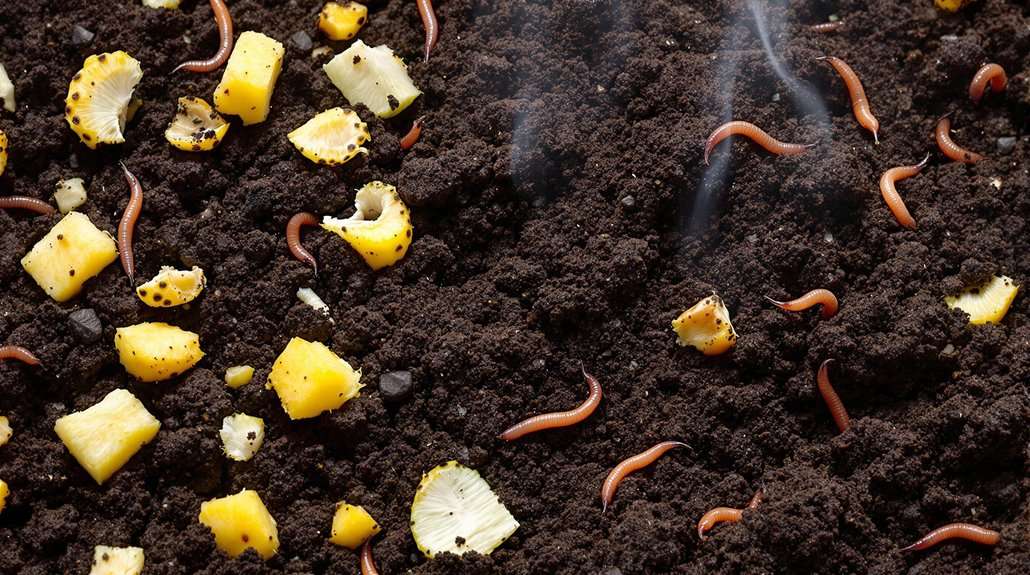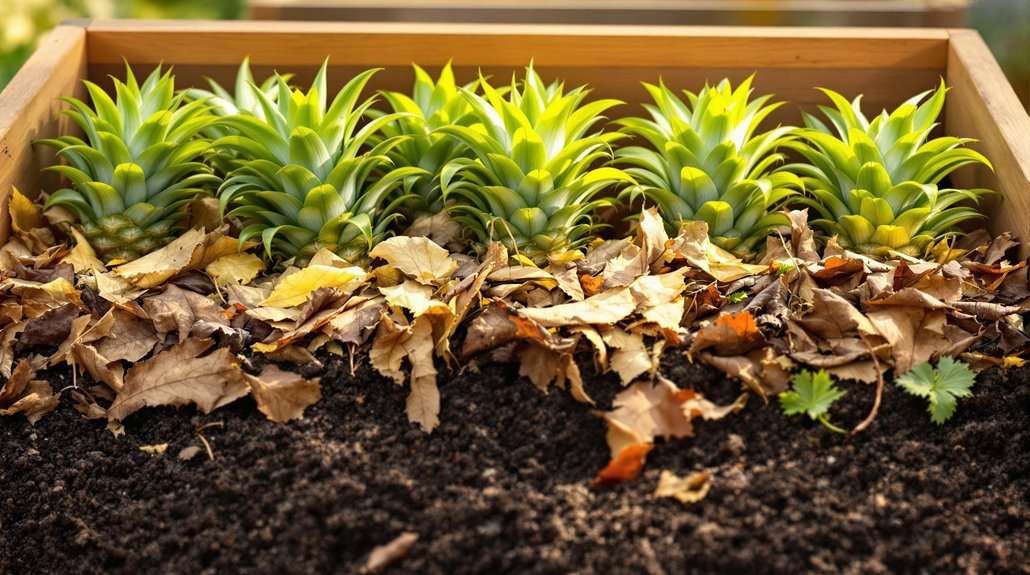Can You Compost Pineapple
You can definitely compost pineapple, including all parts of the fruit – the crown, flesh, core, and rind. To get the best results, cut your pineapple scraps into small pieces and mix them with brown materials like dried leaves or cardboard in a 1:2 ratio. The fruit's high water content and rich nutrient profile make it excellent for composting, but you'll need to bury the pieces in the center of your pile to prevent fruit flies and manage potential odors. Regular turning and proper moisture maintenance will help break down the fibrous material within 2-3 months. With the right techniques, you'll transform your pineapple waste into valuable, nutrient-rich compost for your garden.
This post may contain affiliate links. If you make a purchase through these links, I may earn a commission at no additional cost to you. Additionally, portions of this post may be generated using artificial intelligence (AI) technology. While we strive for accuracy, please be aware that AI-generated content may not always be perfect and should be fact-checked when necessary.
The Spatula Scoops
- Pineapple is completely compostable and provides essential nutrients, vitamins, and minerals that enrich your compost pile.
- Cut pineapple into small pieces, including the crown, flesh, core, and base, to speed up decomposition.
- Mix pineapple scraps with brown materials in a 1:2 ratio to maintain proper carbon-nitrogen balance.
- Bury pineapple waste in the center of your compost pile to prevent fruit flies and manage odors.
- Expect pineapple scraps to decompose within 2-3 months when using proper composting techniques and regular pile turning.
Benefits of Pineapple in Compost

Pineapple waste is a powerhouse addition to your compost pile, offering multiple benefits for soil health and sustainability. When you add pineapple to your compost, you're introducing a rich source of vitamins, minerals, and essential nutrients that will enhance your final product's quality. The fruit's high water content (86%) helps maintain ideal moisture levels without oversaturating your pile.
The pineapple's acidity level ranges from 3.5 to 4.5 pH, making it important to balance with other materials. You'll find that pineapple contributes both carbon and nitrogen to your compost, creating a perfect balance for decomposition. The fibrous skin breaks down slowly, providing necessary carbon, while the flesh offers nitrogen-rich material. When you compost pineapple, you're also supporting environmental sustainability by diverting waste from landfills and reducing greenhouse gas emissions.
The fruit's natural properties make it particularly valuable for soil improvement. As it decomposes, pineapple helps balance soil pH levels and enhances soil structure through calcium contribution. You'll notice improved water retention and aeration in your garden soil, while the decomposed fruit attracts beneficial earthworms and microorganisms. These microscopic helpers accelerate the composting process and create a thriving ecosystem within your soil.
Preparing Pineapple for Composting
To maximize these composting benefits, proper preparation of your pineapple scraps is key. You'll want to start by thoroughly rinsing your pineapple to remove any pesticide residues, then separate it into its main components: crown, flesh, core, and base. Cut each part into small pieces, as this increases the surface area and speeds up decomposition. Balanced compost requires maintaining a 1:2 ratio of pineapple scraps to brown materials like dried leaves.
For the tougher parts like the crown and base, you'll need to be particularly thorough in your chopping. Break these down into smaller segments, about 1-2 inches in size, to guarantee they decompose at a similar rate to the softer portions. When handling the core, cut it into thin strips or small chunks, as its fibrous nature can make it slower to break down. Don't forget to separate excess flesh from the skin, but keep both for composting, as they contain different beneficial nutrients. Remember, you shouldn't compost whole pineapples or large chunks, as they can create oxygen-deprived pockets in your pile, leading to slow decomposition and potential odor issues. Instead, distribute your chopped pineapple pieces evenly throughout your compost pile.
Best Composting Methods

When it comes to composting pineapple scraps, you'll find several effective methods that suit different needs and circumstances. Hot composting is particularly effective for breaking down pineapple's tough, fibrous material quickly, as it maintains high temperatures that accelerate decomposition and kill potential pathogens. If you're willing to manage the process actively, you'll need to maintain proper moisture levels and turn the pile frequently. The process requires a careful mix of browns and greens to achieve optimal decomposition.
For those with limited space or primarily kitchen waste, vermicomposting offers an excellent alternative. Red wiggler worms will readily process pineapple scraps, though you'll want to cut them into smaller pieces and avoid overwhelming your worm population with too much acidic material at once. Cold composting methods, while requiring less maintenance, will take longer to break down pineapple waste but remain a viable option if you're not in a hurry.
You might also consider combination methods, such as starting with a tumbler for initial breakdown and then transferring partially decomposed pineapple material to a traditional pile or vermicomposting bin. This approach can help manage the fruit's acidity while ensuring thorough decomposition.
Common Composting Challenges
Composting pineapple scraps can run into several common challenges that you'll need to watch out for. One of the most frequent issues you'll encounter is moisture control, as pineapple's high water content can quickly lead to an overly wet pile. If you notice water dripping when you squeeze a handful of compost, you'll need to add dry materials like leaves or straw to restore balance. Adding scrunched up newspaper can help absorb excess moisture in your pile.
Temperature management can also become tricky when composting acidic fruits like pineapple. You'll want to maintain your pile at 140-160°F for ideal decomposition, which requires regular turning and proper sizing. If your pile's too small, it won't generate enough heat, while an oversized pile might overheat and slow down the composting process. Having a reliable stainless steel mesh strainer can be helpful in separating compost materials.
Odors and pest attraction can become problematic if you're not careful with your pineapple scraps. To prevent these issues, always bury fruit waste beneath carbon-rich materials and maintain proper aeration. If you notice ammonia-like smells, add more brown materials like dried leaves or wood chips. For sulfurous odors, turn your pile more frequently to increase oxygen flow.
Successful Pineapple Composting Tips

Success with pineapple composting starts with proper preparation and layering techniques. You'll want to begin by thoroughly washing your pineapple waste and chopping it into smaller pieces to speed up decomposition. When preparing the different parts, remember that the crown and base will take longer to break down, so they'll need extra attention. Adding crushed eggshells to your pile will help balance the natural acidity of pineapple waste.
To guarantee ideal composting conditions, follow these essential steps:
- Start with a brown material base layer for proper drainage and aeration
- Add your chopped pineapple waste mixed with other green materials
- Cover with another layer of browns to maintain the vital 30:1 carbon-to-nitrogen ratio
You'll get the best results by burying your pineapple waste deep within the pile's center, which helps prevent pest problems and maintains proper decomposition temperatures. Don't forget to turn your pile regularly to provide adequate oxygen flow and prevent anaerobic conditions. If you're using a cold composting method, you'll need to cover the pile with a metal or wood sheet, while hot composting will process your pineapple waste more quickly. With proper management, you can expect your pineapple waste to decompose in about 2-3 months, creating nutrient-rich compost for your garden.
Frequently Asked Questions
How Long Does It Take for Pineapple Waste to Completely Decompose?
Did you know that properly shredded pineapple waste can decompose twice as fast as whole pieces? You'll typically see complete decomposition of pineapple waste in 2-6 months, depending on your composting conditions. Your breakdown time will vary based on how you prepare the waste – chopping it into smaller pieces, maintaining proper moisture levels, and regular turning of your compost pile will greatly speed up the process.
Can You Compost Pineapple if You Have Limited Outdoor Space?
You can definitely compost pineapple in limited outdoor space by using compact methods like bokashi bins or vermicomposting systems. To make it work, you'll need to chop the pineapple scraps into small pieces and layer them properly with brown materials. Consider using a small-footprint compost bin or vertical composting system for your balcony or patio. Just remember to maintain proper aeration and moisture levels to prevent odors.
Will Composting Pineapple Attract Fruit Flies to My Indoor Compost Bin?
Yes, pineapple in your indoor compost bin can attract fruit flies, as they're drawn to sweet, fermenting fruit. You'll need to take preventive measures like burying pineapple scraps under brown materials (such as dried leaves or paper), ensuring your bin has a tight-fitting lid, and maintaining proper moisture levels. Consider adding a layer of soil on top of fresh additions and using vinegar traps nearby to catch any persistent flies.
Does the Sugar Content in Pineapple Affect the Composting Process?
Yes, pineapple's sugar content greatly impacts composting. You'll find that these sugars can speed up decomposition by attracting beneficial microorganisms, but they'll also draw unwanted pests. To manage this, you'll need to maintain proper carbon-to-nitrogen ratios and bury pineapple scraps deep within your pile. The sugars will ultimately contribute to richer compost, though you'll want to monitor moisture levels and turn your pile regularly.
Can Pineapple Compost Harm Pets if They Accidentally Consume It?
Like a ticking time bomb in your backyard, pineapple compost can pose serious risks to your pets if they consume it. You'll need to watch out for potential dangers including acidic content, harmful bacteria from decomposition, and possible pesticide residues. Your pets might experience vomiting, diarrhea, and lethargy if they eat composted pineapple material. It's essential to secure your compost bins with tight-fitting lids and supervise your pets around composting areas.





